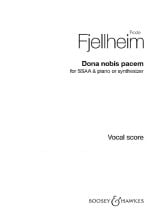Fjellheim, Frode (Fjellheim) - Dona nobis pacem (SSAA & Piano)
Originally composed for solo voice, Dona nobis pacem combines the vocal style of the yoik tradition (a Sami form of song) and a more classical female vocal style. This arrangement for upper voices, as recorded by Cantus on their album Northern Lights, develops this vocal palette further (as does the SATB version also available).
The piano part is supplied alongside chord symbols, which allow a freer approach to accompaniment, and this may also be supplemented by the optional accordion/wind instrument and percussion parts. All the lyrics, except the words 'Dona nobis pacem', are so called yoik syllables with no linguistic meaning (for which a pronunciation guide is included), as used within the Sami yoik tradition.
Fjellheim's distinctive and approachable musical language, which many will recognise from the use of his music at the opening of Disney's Frozen, will appeal to both singers and audience.
Composer's Note
Dona Nobis Pacem started as an idea from the singer Anne Vada, who asked me to contribute to an album she released in 2009. I composed this song by combining the vocal style of the yoik tradition and a more classical female vocal style. On the recording from 2009 the yoik-like part was performed by me, and the classical voice by Anne Vada. Later I developed the composition for both SATB and SSAA choir, and tried to broaden the vocal palette even further. The lower parts could very well be performed in a more folk-like style without too much vibrato, while the upper parts could have a more ‘angel-like’ quality. The piano and optional accompaniment instruments could be played freely using the chord symbols and notation as a guide. It is possible to perform the song using only a choir and a piano, but then the accordion or wind instrument part should be played by the pianist (at rehearsal mark C). All the lyrics, except the words ‘Dona nobis pacem’, are so called yoik syllables with no linguistic meaning, as used within the Sámi yoik tradition. The following may be used as a guide:
a – as in ‘far’
o – as in ‘on’
j – as in ‘yes’
Frode Fjellheim - 2017

